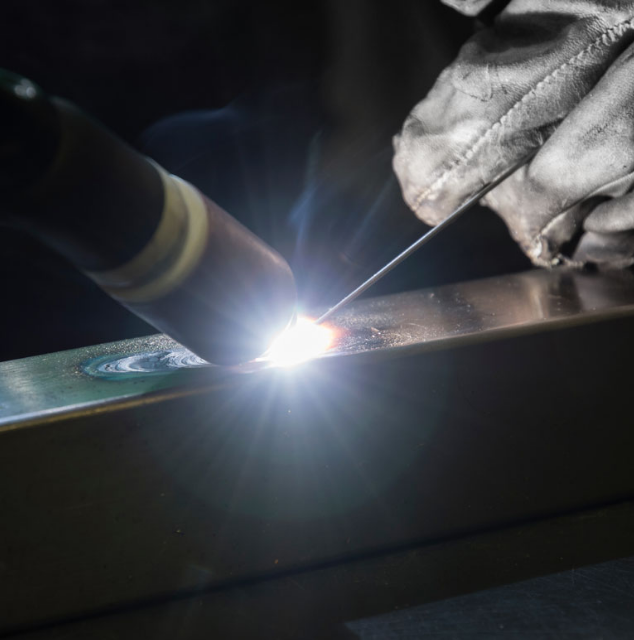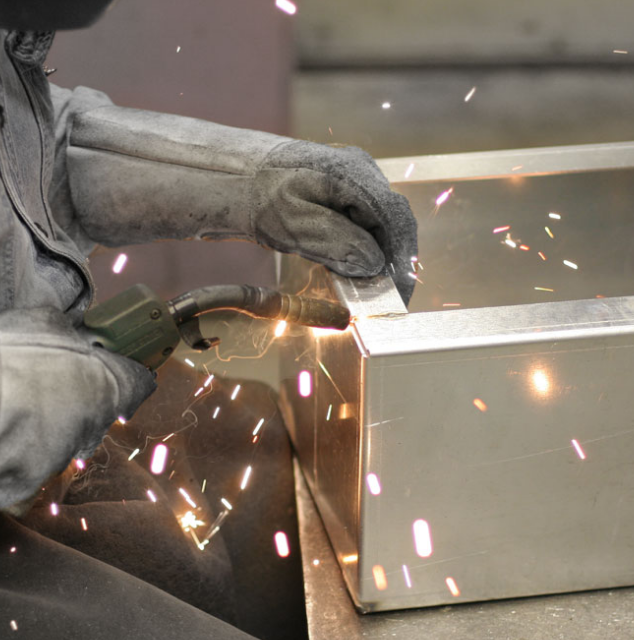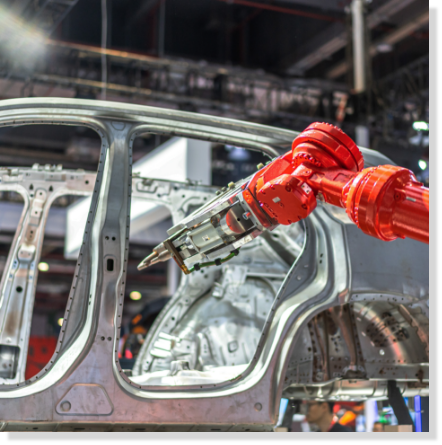
Women-Owned Business

NS ARC’s Tungsten Inert Gas (TIG) or Gas Tungsten Arc (GTAW) welding wire cut lengths offer exceptional control to produce clean, dependable, and quality welds. Our TIG wire cut lengths empower welders around the world with strength and durability that exceed industry standards while ensuring superior resistance to corrosion and cracking. This wire is ideal for welding multiple thicknesses of material, intricate shapes, and materials in a variety of positions. Continue reading to discover more about the advantages of NS ARC’s TIG welding wire cut lengths and how our welding solutions can match your application, maximize your welding efficiency, and optimize your end results.
TIG welding and MIG welding are both popular techniques, but both are quite different and require different materials.

TIG Welding Wire Qualities
Using TIG filler wire requires far greater skill and precision than MIG welding since TIG welding is done manually as opposed to with the semi-automatic-feed process of MIG (GMAW). In TIG welding, a tungsten electrode generates heat that melts the filler metal and the base metal to create a weld pool. TIG filler wire cut lengths also vary in diameter from MIG wire which typically ranges from 0.010 to 0.125 inches in diameter.
MIG Welding Wire Qualities
MIG welding utilizes semi-automatic and automatic wire feeding via a welding gun. The base metal is heated via an electrode (the filler metal wire) where the current is transferred from the welding gun to the welding wire, then transferred across the arc to the base material to create the final weld joint. To protect the weld from contamination and impurities, a shielding gas typically consisting of argon and carbon dioxide may be used. Generally, MIG welding wire ranges from 0.023 to 0.063 inches in diameter.


Method
TIG welding wire requires hand welding and manual manipulation while MIG wire is fed semi-automatically and automatically via a welding gun.

Diameter
TIG welding filler wire generally has a broader range in diameter than MIG welding wire.

Skill Level
TIG welding requires more skill than MIG welding, requiring a steady hand in order to achieve optimal consistency and uniformity.

Welding Process
TIG welding is renowned for producing high-quality, precise, and clean welds while MIG welding is known for increased productivity and efficiency.

TIG welding requires specific types of welding filler wire in order to produce a reliable and successful weld that will keep. Our experts at NS ARC manufacture our welding wire to provide numerous benefits, such as greater resistance to corrosion, ductility, and versatility. Be sure to contact us directly if you have any questions regarding what types of wire we have available.
Aluminum welding filler wire is made from high-quality aluminum alloy and is designed to be a reliable choice when used with TIG welding. Compared to other types of welding wire, aluminum wire is soft and malleable, making it easy to feed into the weld pool. NS ARC currently has several types of aluminum welding filler wire for TIG welding, each with its unique properties and advantages.
Most commonly used; suitable for welding aluminum alloys with a silicon content of 5% or less; produces a weld with good fluidity and crack resistance.
Suitable for welding aluminum alloys with a magnesium content of up to 5%; produces a weld with excellent strength and corrosion resistance.
Suitable for welding aluminum alloys with a high silicon content, such as those used in the automotive industry; produces a weld with break resistance and preserved ductility.
TIG welding is a popular welding process in many industries that require high-quality and precise welding. Most of these heavy-duty industries are incredibly demanding, so they require optimal welding capabilities in order to produce successful welds.

For this industry, TIG welding is especially useful when working on exhaust systems, fuel tanks, and other components made from stainless steel, aluminum, and other metals. From body panels and frames to cylinder heads and turbochargers, TIG welding is utilized to produce solid welds that can handle high temperatures and engine pressure.
Learn more
TIG welding is a reliable technique for the construction industry due to its ability to produce high-quality welds, versatility, lack of spatter, and suitability for welding in tight spaces. Welders experience superior precision and control when producing quality welds that uphold the structural integrity of the project.
Learn more
TIG welding is especially useful for power generation in the energy industry to weld components made from high-temperature metals, such as nickel alloys and titanium. Welders use it to produce welds that are critical in power generator operations.
Learn more
Widely used in metal fabrication for applications like welding sheet metal, tubing, and structural components, TIG welding provides a high level of precision as well as a high-quality finish. By producing clean and precise welds, TIG welding wire is especially ideal for manufacturing and fabricating thinner materials and components that require a high degree of accuracy and control.
Learn more
TIG welding is used in the transportation industry for applications that require a high level of accuracy and control, such as welding delicate parts of a vehicle’s engine or exhaust system. TIG welding produces a clean and precise weld that minimizes the risk of defects, such as porosity, that can weaken the weld and compromise the safety of the vehicle.
Learn moreTIG welding is also a popular choice in other applications that utilize TIG welding’s unique advantages, including high precision and control, very clean welds, and versatility. Some of the other applications that utilize TIG welding filler wire include:
TIG welding is known for its precise control over the welding arc, making it suitable for when accuracy is critical, especially when handling the aluminum and stainless-steel materials that are common in agricultural equipment.
TIG welding is used to join the structural components of railcars, such as frames and bodies, producing strong and durable welds that can withstand the stresses and vibrations that railcars endure during operation.
With TIG welding, the precise control over the welding process helps ensure the integrity and strength of joined ship components, which are essential for the structural stability of the vessel. TIG welding is well-suited for common marine materials like aluminum and stainless steel, as it produces clean and high-quality welds with minimal distortion.
TIG welding is a versatile and reliable welding process that is widely used in many applications that require high-quality and precise welding. Applications like agricultural equipment, railcars, and shipbuilding all depend on precision and control over the entire welding process to minimalize overheating, distortion, and porosity. Each of these applications depend on both the high-quality method of welding and the skills of the welder to get the job done right. By relying on NS ARC TIG welding filler wire, businesses around the world can weld with confidence and trust that their welding projects can be completed with high precision and consistency.
TIG welding wire cut lengths offer a number of unique benefits that enable precise welds in a variety of applications. Some of the most prominent benefits and advantages of TIG welding filler wire include:

TIG welding filler wire enables precise welding due to the handheld welding process. This makes TIG welding filler wire ideal for welding multiple thicknesses of material, intricate shapes, or delicate projects. The weld bead produced is clean and precise, which is especially important when welding materials that require a high level of accuracy.

TIG welding can be used in various positions, including overhead, flat, vertical, and horizontal, making it a highly adaptable welding solution. This is opposed to other welding methods like metal-cored welding, which is fixed to flat and horizontal positions.

TIG welding filler wire can be used to weld a variety of materials, including aluminum, stainless steel, copper, and brass. This transfers across many applications in several industries that require precise, controlled, and high-quality welds.

The time and effort required for post-weld finishing is reduced when utilizing NS ARC TIG welding filler wire. Thanks to the controlled nature of the TIG welding process and the tight control over the manufacturing process of the filler metal, the welds produced are often very clean and require minimal cleanup.

NS ARC Aluminum TIG filler metal is formulated to provide a high resistance to corrosion and cracking. Our TIG welding wire cut lengths help produce strong, durable and reliable welds. The careful attention to chemistry gives an increased level of control of heat input which significantly reduces the risk of overheating or burning the base material to ensure a high level of quality and strength in the weld joint.
TIG welding is a highly precise, versatile, and reliable welding process that produces clean and strong welds. If you require direct consultation on whether NS ARC TIG welding filler wire may be the right solution for your application, simply get in contact with us today. One of our experts will be in touch with you to discuss how our solutions can improve your welding operations.
Our team of welding experts is available to provide you with the information that you’re looking for, whether you need some guidance or advice for your next welding project or you’re not sure which welding wire best suits your application.
If you have any questions before making a purchase chat with our online operators to get more information.
Ask An Expert or find our Questions & Answers
